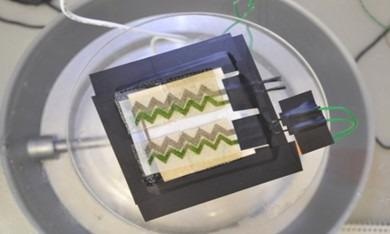For several years, researchers have been trying to reconfigure the mechanisms of photosynthesis in cyanobacteria to extract energy. This may make it possible to meet a significant portion of the world's energy requirements from the combination of cyanobacteria, sunlight, and water.

Image Credit: Dudarev Mikhail/Shutterstock.com
The future of solar energy looks brighter than ever before. It is evident that most of the world's energy consumption will come from solar energy in the near future.
At the same time, there are several serious obstacles in the way of further development of the industry. The sunlight conversion efficiency of silicon panels has almost reached its maximum. Therefore, there is an active search for opportunities to take solar energy to a new level.
In addition to the classical technologies for creating solar panels, there is also a less popular direction - biophotovoltaics. It uses bacteria capable of photosynthesis to convert sunlight into an electric current.
How Bacteria Converts Sun Light into Electricity
In the presence of water and light, cyanobacteria splits water molecules into molecular oxygen, a hydrogen ion, and an electron. This electron can be captured by one electrode and then used at another electrode to convert oxygen and hydrogen back into the water. Using photosynthetic microorganisms to convert sunlight into electrical energy is called biophotovoltaics.
Research and Development
Scientists have created quite a few variants of biological solar panels, but they all remain only laboratory prototypes.
One of the reasons for this is that the lifetime of bacteria is short for real applications due to insufficient biocompatibility.
Manu Sebastian Mannoor and his colleagues at Stevens Technological University increased the lifetime of cyanobacteria in biophotovoltaic devices by using fungus as a substrate.
They used mushrooms as the basis for biological solar panels that generate electricity thanks to light-sensitive cyanobacteria.
Experiments with 3D-printed prototypes have shown that mushrooms increase the survival of bacteria after printing. In addition, measurements of electrical characteristics have shown that the maximum current generated is about 67 nano amperes, and 3D printing of organized structures increases the amount of current compared to evenly distributed bacteria.
Researchers at Imperial College London demonstrated a unique energy-generating wallpaper produced by using cyanobacteria as an ink. Cyanobacteria were printed from an inkjet printer to generate patterns on electrically conducting carbon nanotubes and paper.
According to the study, the microbes survived the printing process and were able to undertake photosynthesis, producing a modest quantity of electricity for 100 hours. The developers call their product a two-in-one, bio-battery and a solar panel at the same time. The new tablet-sized material could provide enough electricity to power a digital clock or an LED light bulb.

Photograph of the experimental setup (excluding the potentiostat), showing a pair of BPV modules printed in series. Image Credit: Sawa, M., Fantuzzi, A., Bombelli, P., Howe, C. J., Hellgardt, K., & Nixon, P. J. (2017)
Canadian scientists from the University of British Columbia decided to approach it differently. They embodied E. coli bacteria instead of cyanobacteria as solar cells, which have a promising application in solar energy harvesting under high cloud conditions. In addition, these bacteria actively release a large amount of lycopene, a natural dye that has great potential in converting heat into electricity.
Latest Research
Researchers at the University of Cambridge have 3D printed a grid of high-rise nano-housing in which cyanobacteria can grow rapidly. With this setup, scientists were able to extract more energy generated during photosynthesis from bacteria, which can be used to power small electronics.
The researchers considered that cyanobacteria must be coupled to electrodes to gather the energy they create through photosynthesis. Therefore, 3D printing was used to create electrodes consisting of metal oxide nanoparticles organized in densely packed sets of poles that resembled a miniature city with high-rise structures.
This city was populated by cyanobacteria, which produced electricity with great efficiency. The useful output of the system was so great that the amount of incoming energy increased by more than an order of magnitude. Another strength of this approach is that this printing technique can produce nanostructures of customizable length, which will benefit various fields and projects.

The University of Cambridge's 3D-printed custom electrodes. Image Credit: Gabriella Bocchetti/University of Cambridge
Benefits of a Biophotovoltaic System
The benefit of a biophotovoltaic system over traditional solar systems is that its components (bacteria) are capable of reproduction, self-healing and can store energy in the dark. In addition, this process is environmentally friendly and produces no chemical waste.
The researchers believe that this discovery will pave the way for new electronic gadgets constructed as a by-product of generating electricity from bacteria. Disposable power supply integrated with paper sensors to monitor patients for medical purposes and environmental sensors to monitor interior air quality are just a few examples.
Future Developments
Scientists have long studied the ability of photosynthetic bacteria to convert sunlight, carbon dioxide and water into energy. By providing microorganisms with suitable housing, scientists have opened up new horizons in the bioenergy field.
Unfortunately, biophotovoltaics is currently limited by the high cost of devices, low productivity, and short service life. But scientists are confident that sooner or later, it will be brought to a commercial level.
References and Further Reading
Chen, X., Lawrence, J. M., Wey, L. T., Schertel, L., Jing, Q., Vignolini, S., ... & Zhang, J. Z. (2022). 3D-printed hierarchical pillar array electrodes for high-performance semi-artificial photosynthesis. Nature Materials, 1-8. https://doi.org/10.1038/s41563-022-01205-5
Eurekalert. (2022). Tiny ‘Skyscrapers’ Help Bacteria Convert Sunlight into Electricity. [Online] University Of Cambridge. Available at: https://www.eurekalert.org/news-releases/945274 (Accessed on 20 March 2022).
Joshi, S., Cook, E., & Mannoor, M. S. (2018). Bacterial nanobionics via 3D printing. Nano Letters, 18(12), 7448-7456. https://doi.org/10.1021/acs.nanolett.8b02642
Sawa, M., Fantuzzi, A., Bombelli, P., Howe, C. J., Hellgardt, K., & Nixon, P. J. (2017). Electricity generation from digitally printed cyanobacteria. Nature Communications, 8(1), 1-10. https://doi.org/10.1038/s41467-017-01084-4
Srivastava, S. K., Piwek, P., Ayakar, S. R., Bonakdarpour, A., Wilkinson, D. P., & Yadav, V. G. (2018). A biogenic photovoltaic material. Small, 14(26), 1800729. https://doi.org/10.1002/smll.201800729
Tschörtner, J., Lai, B., & Krömer, J. O. (2019). Biophotovoltaics: green power generation from sunlight and water. Frontiers in microbiology, 10, 866. https://doi.org/10.3389/fmicb.2019.00866
Disclaimer: The views expressed here are those of the author expressed in their private capacity and do not necessarily represent the views of AZoM.com Limited T/A AZoNetwork the owner and operator of this website. This disclaimer forms part of the Terms and conditions of use of this website.